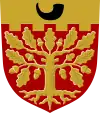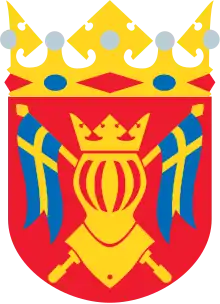Halikko
Halikko (Finnish pronunciation: [ˈhɑlikːo]) is a former municipality of Finland that existed until December 31, 2008. On January 1, 2009 the municipality was merged with the larger neighboring Salo. Before the merge Halikko had become a rapidly urbanizing rural area.[1]
Halikko | |
|---|---|
| Halikon kunta Halikko kommun | |
 Coat of arms | |
| Country | Finland |
| Province | Western Finland |
| Region | Southwest Finland |
| Sub-region | Salo |
| Merged with Salo | January 1, 2009 |
| Government | |
| • City manager | Simo Paassilta |
| Area | |
| • Total | 357.31 km2 (137.96 sq mi) |
| • Land | 356.79 km2 (137.76 sq mi) |
| • Water | 0.52 km2 (0.20 sq mi) |
| Area rank | 260th |
| Population (2003) | |
| • Total | 9,374 |
| • Rank | 112th |
| • Density | 26/km2 (68/sq mi) |
| +1.4 % change | |
| Time zone | UTC+2 (EET) |
| • Summer (DST) | UTC+3 (EEST) |
| Official languages | Finnish |
| Urbanisation | 68.4% |
| Unemployment rate | 8.7% |
| Climate | Dfb |
| Website | http://www.halikko.fi/ |
It was located in the province of Western Finland and was part of the Southwest Finland region. The municipality had a population of 9,491 (2004-12-31) and covered an area of 357.31 km2 (excluding sea) of which 0.52 km2 was inland water. The population density was 26.60 inhabitants per km2.
The municipality was unilingually Finnish.
History
There is evidence that areas in Halikko has been settled in the Stone Age. One of the prehistoric villages, Rikala, became an important trade and meeting place on the Finnish coast during the Iron Age. The vikings sailed to Rikala to trade with the finns. Several Iron Age treasures has been found in Halikko, e.g. the Treasure of Halikko.
In the first centuries of the Swedish rule in Finland, the land was given to the ruling class. Manors of Åminne, Vuorentaka and Wiurila were founded and they became powerful owners in Halikko. The oldest documented record of Halikko is from 1313. The stone church of Halikko was built in 1440.
The mucipality of Halikko was formed in 1865 due to the municipal reform. The count of Wiurila became the first municipal manager. In 1932 Halikko had to give land to its growing neighbour Salo. In 1967 the municipality of Angelniemi was merged with Halikko.
On January 1, 2009 Halikko ceased to exist as it was attached to the City of Salo. The territory of the former Halikko thus changed status from rural to urban.
Name
The name Halikko is mentioned for the first time in 1313. One theory is that the name derives from the Germanic name Halicho or Halik.[2]
See also
References
- FACTA - tietosanakirja, p 206. WSOY, 2006. ISBN 951-0-31930-9 (in Finnish)
- "Archived copy". Archived from the original on 2012-02-27. Retrieved 2010-07-08.CS1 maint: archived copy as title (link)

